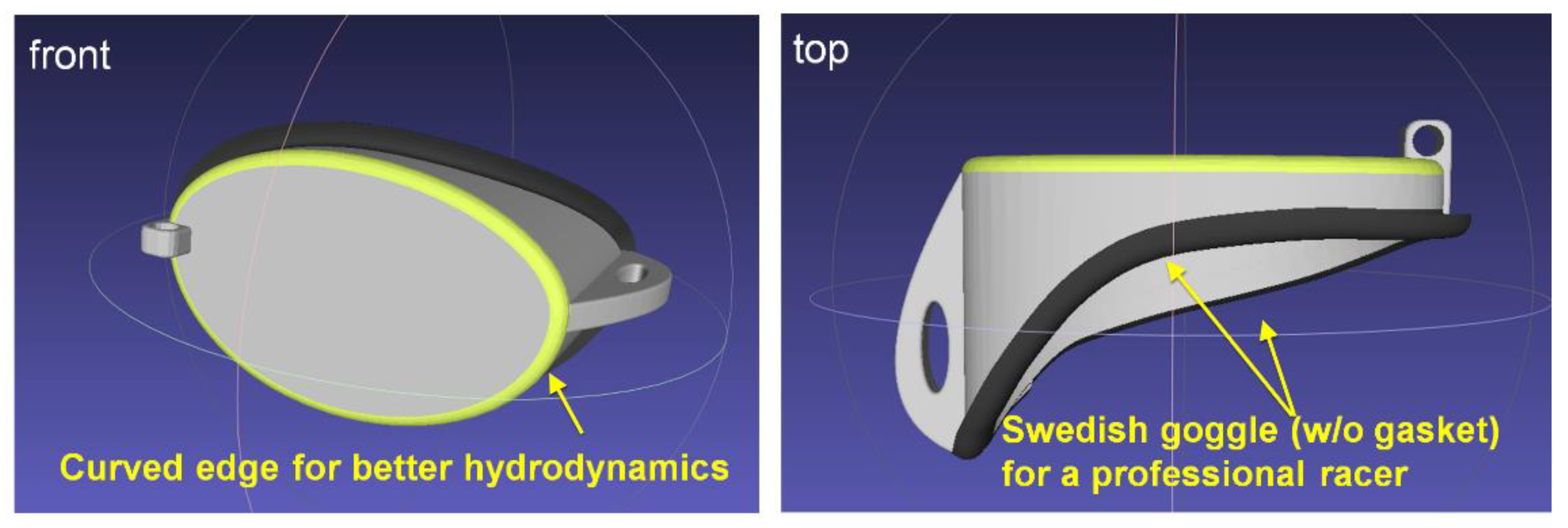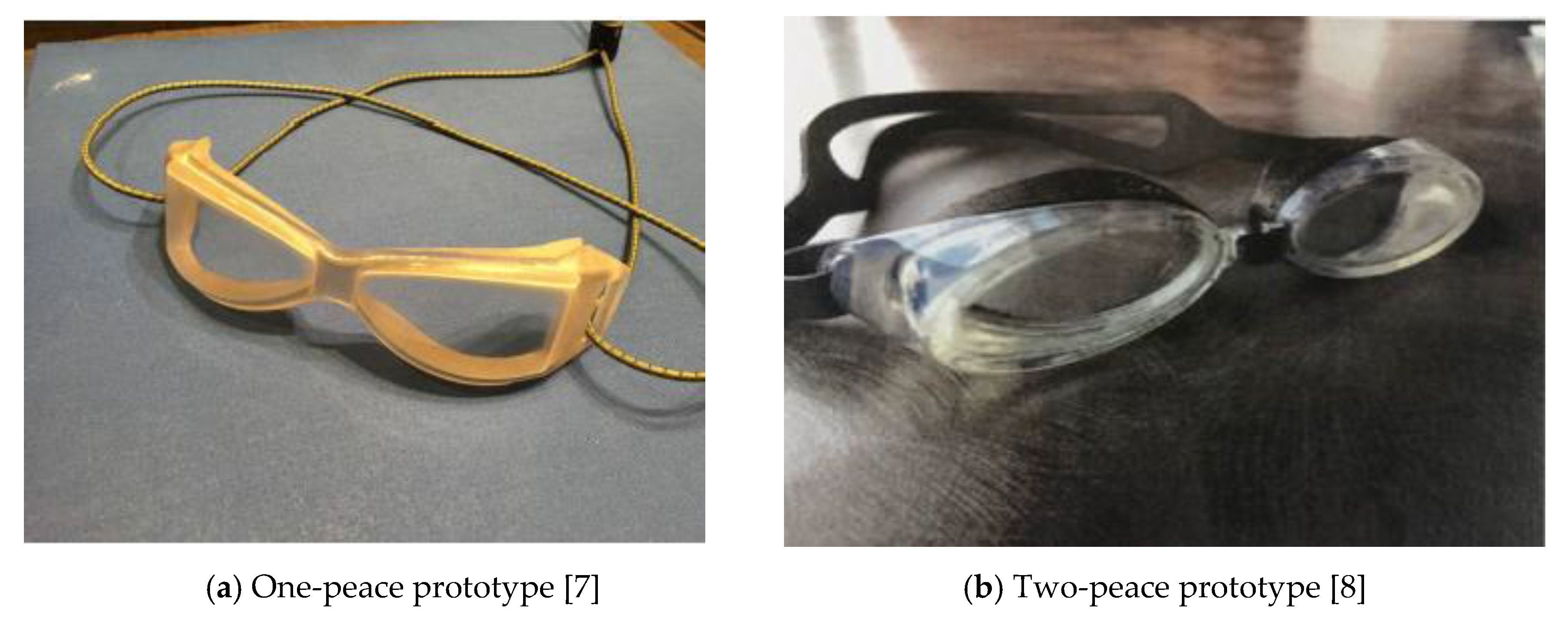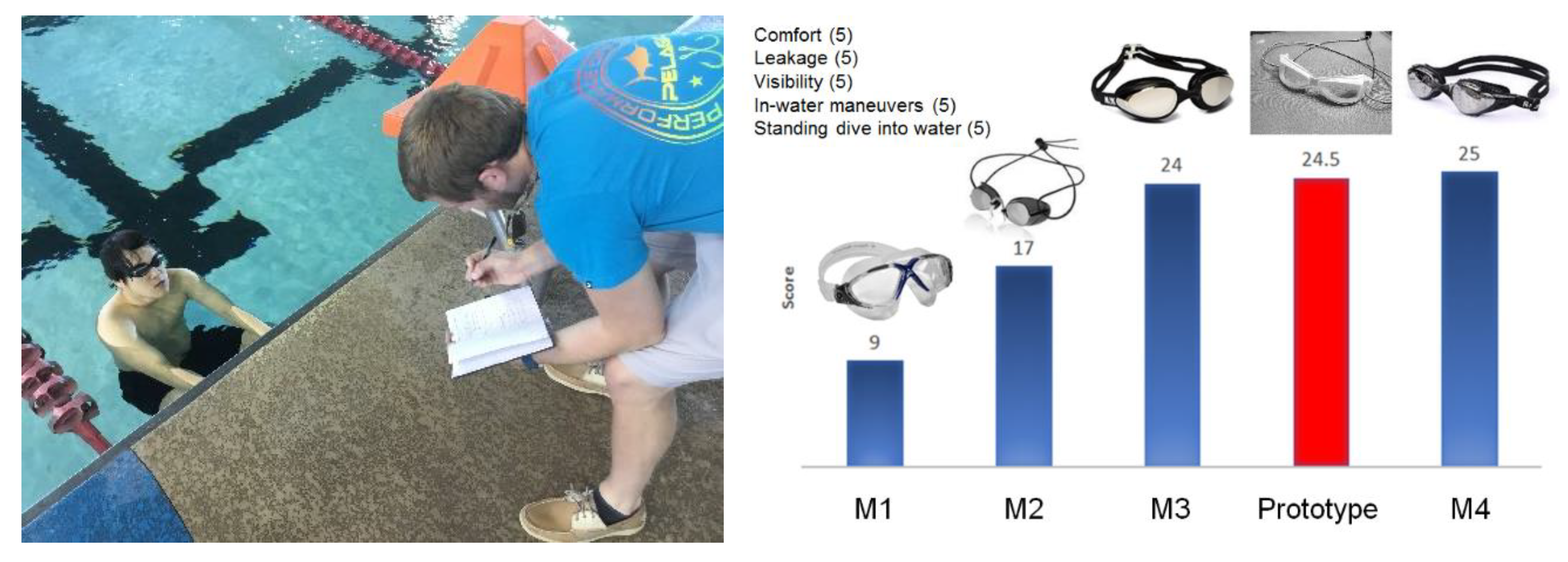Comparison of Design Characteristics and Customization Protocols for Swimming Goggles
Abstract
:1. Introduction
2. Design Characteristics of Swimming Goggles
3. Design Protocols of Customized Swimming Goggles
4. Discussion
5. Conclusions
Author Contributions
Funding
Conflicts of Interest
References
- Weisel, C.P.; Richardson, S.D.; Nemery, B.; Aggazzotti, G.; Baraldi, E.; Blatchley, E.R., III; Blount, B.C.; Carlsen, K.H.; Eggleston, P.A.; Frimmel, F.H.; et al. Childhood asthma and environmental exposures at swimming pools: State of the science and research recommendations. Environ. Health Perspect. 2008, 117, 500–507. [Google Scholar] [CrossRef] [PubMed] [Green Version]
- Kumar, A.; Bisht, D.S. A User-Centred Design Approach to Investigate the Design Parameters for Prescription Swimming Goggles. In Research into Design for a Connected World; Springer: Singapore, 2019; pp. 475–485. [Google Scholar]
- Morgan, W.H.; Cunneen, T.S.; Balaratnasingam, C.; Yu, D.Y. Wearing swimming goggles can elevate intraocular pressure. Br. J. Ophthalmol. 2008, 92, 1218–1221. [Google Scholar] [CrossRef] [PubMed] [Green Version]
- Sommer, A. Intraocular pressure and glaucoma. Am. J. Ophthalmol. 1989, 107, 186–188. [Google Scholar] [CrossRef]
- Leskea, M.C.; Heijl, A.; Hyman, L.; Bengtsson, B.; Komaroff, E. Factors for progression and glaucoma treatment: The Early Manifest Glaucoma Trial. Curr. Opin. Ophthalmol. 2004, 15, 102–106. [Google Scholar] [CrossRef]
- Ma, K.T.; Chung, W.S.; Seo, K.Y.; Seong, G.J.; Kim, C.Y. The effect of swimming goggles on intraocular pressure and blood flow within the optic nerve head. Yonsei Med. J. 2007, 48, 807–809. [Google Scholar] [CrossRef] [PubMed]
- Coleman, J.; Hernandez, C.; Hernandez, J.; Hubenak, S.; McBride, A.; Mehrubeoglu, M.; Park, J. Development of a Design Protocol for Customized Swimming Goggles Using 3D Facial Scan Data. In Proceedings of the International Conference on Applied Human Factors and Ergonomics, Los Angeles, CA, USA, 17–21 July 2017; Springer: Cham, Switzerland, 2017; pp. 1017–1021. [Google Scholar]
- Park, J.; Mehrubeoglu, M.; Baca, J.; Rylance, K.; Almoosa, H.; Salazar, G.; Franks, C.; Falahati, S. Development of a Design Protocol for Customized Swimming Goggles Using 2D Facial Image Data. In Proceedings of the International Conference on Applied Human Factors and Ergonomics, Orlando, FL, USA, 21–25 July 2018; Springer: Cham, Switzerland, 2018; pp. 151–155. [Google Scholar]
- Park, J.; Khamnasak, W.; Crawford, J.; Bonds, J.; Hernandez, E.; Mehrubeoglu, M. Development of Ergonomic Swimming Goggles Based on Benchmarking and 3D Facial Scan. In Proceedings of the International Conference on Applied Human Factors and Ergonomics, Washington, DC, USA, 24–28 July 2019; Springer: Cham, Switzerland, 2019; pp. 43–48. [Google Scholar]
- Sporti Antifog Swedish Goggle + Bungee Strap. Available online: https://www.swimoutlet.com/p/sporti-antifog-swedish-goggle-bungee-strap-21093 (accessed on 11 April 2020).
- Sporti Antifog Optical Pro II Mirrored Goggles. Available online: https://www.swimoutlet.com/p/sporti-antifog-optical-pro-ii-goggle-22390 (accessed on 11 April 2020).
- Speedo Adult 3PK Goggles. Available online: https://www.swimoutlet.com/p/speedo-adult-3pk-goggles-8178448 (accessed on 11 April 2020).
- Amanzi Axion Mirrored Goggle. Available online: https://www.amanziswimwear.com/amanzi-axion-silver-black-white-mirrored-lens-goggles (accessed on 6 April 2020).
- Sporti Antifog Cabo Mirrored Goggle. Available online: https://www.swimoutlet.com/p/sporti-antifog-cabo-mirrored-goggle-8177965 (accessed on 11 April 2020).
- Arena The One Jr. Goggle. Available online: https://www.arenawaterinstinct.com/en_global/001432-the-one-junior-goggles.html (accessed on 7 April 2020).
- Sporti Antifog Swedish Mirrored Goggle + Bungee Strap. Available online: https://www.swimoutlet.com/p/sporti-antifog-swedish-mirrored-goggle-bungee-strap-19702 (accessed on 11 April 2020).
- Speedo Vanquisher EV Goggle. Available online: https://www.speedousa.com/vanquisher-ev-goggle-style-7750318 (accessed on 7 April 2020).
- Sporti Antifog S3 Mirrored Goggle. Available online: https://www.swimoutlet.com/p/sporti-antifog-s3-mirrored-goggle-8119497/?color=58867 (accessed on 7 April 2020).
- Zone 3 Vapour Polarized Revo. Available online: https://zone3.us/collections/goggles/products/vapour-goggles (accessed on 7 April 2020).
- Speedo Speed Socket 2.0 Mirrored Goggle. Available online: https://www.speedousa.com/speed-socket-20-mirrored-goggle-style-7750204 (accessed on 7 April 2020).
- Huub Brownlee Goggle. Available online: https://huubdesign.com/collections/all/products/huub-brownlee-swim-goggle-white-with-yellow-mirror-lens (accessed on 7 April 2020).
- Speedo Futura Biofuse Flexiseal Mirrored Goggle. Available online: https://www.speedousa.com/futura-biofuse-flexiseal-goggle-style-7750286 (accessed on 7 April 2020).
- Speedo Fastskin Elite Mirrored Goggle. Available online: https://thelifeguardstore.com/swim-birmingham-ymca-speedo-fastskin3-elite-mirrored-goggle.html (accessed on 11 April 2020).
- MP Michael Phelps Xceed Goggle. Available online: https://us.michaelphelps.com/products/xceed?variant=27919748431950 (accessed on 7 April 2020).
- TYR Nest Pro Swim Goggle. Available online: https://www.tyr.com/shop/tyr-nest-pro-adult-goggles.html (accessed on 7 April 2020).
- Speedo Vanquisher Optical Goggle. Available online: https://www.speedousa.com/vanquisher-optical-goggle-style-7500601 (accessed on 11 April 2020).
- TYR Tracer Racing Metallized Goggle. Available online: https://www.amazon.com/TYR-Tracer-Racing-Metallized-Goggle/dp/B001MWRRA6 (accessed on 11 April 2020).
- Speedo Speed Socket Mirrored Goggle. Available online: https://www.swimoutlet.com/p/speedo-speed-socket-mirrored-goggle-2929 (accessed on 11 April 2020).
- Aqua Sphere Kayenne Goggle Smoke Lens. Available online: https://us.aquasphereswim.com/products/goggles-kayenne?variant=31253405270102 (accessed on 7 April 2020).
- Aqua Sphere Kaiman Goggle Clear Lens. Available online: https://us.aquasphereswim.com/pages/search-results-page?q=kaiman&gclid=Cj0KCQjw-Mr0BRDyARIsAKEFbee_wilpvzxgMXQoAXK4sM5cSAHc6XWV10Gwc3WmyzBj1ZD6-lDRbUsaAkj6EALw_wcB (accessed on 12 April 2020).
- Arena Cobra Ultra Mirror Goggle. Available online: https://www.arenawaterinstinct.com/en_us/cobra-ultra-mirror.html (accessed on 7 April 2020).
- Nike Swim Chrome. Available online: http://www.nikeswim.com/products/detail/chrome-mirror-training-goggle#001 (accessed on 7 April 2020).
- FINIS Energy Goggle. Available online: https://www.finisswim.com/Energy (accessed on 7 April 2020).
- Zoggs Racespex Goggle. Available online: https://web.metroswimshop.com/showDetailAction.do?productID=ZOGG_300793 (accessed on 11 April 2020).
- MP MichaelPhelps K180 Goggle Smoke Lens. Available online: https://us.michaelphelps.com/products/k180?variant=27885331087438 (accessed on 7 April 2020).
- Shau, D. Swimming Goggles. U.S. Patent 9,486,671, 8 November 2016. [Google Scholar]
- Chiang, H. Swimming Goggles. U.S. Patent 6,289,523, 18 September 2001. [Google Scholar]
- Van Atta, D.S.; Reichow, A.W.; Citek, K.M.; Bruce, R.M. Swimming Goggles. U.S. Patent 7,475,435 B2, 13 January 2009. [Google Scholar]
- Apex, T. Lighter goggles. Reinf. Plast. 2010, 54, 9. [Google Scholar]
- Plaut, G.S. Diplopia in a swimmer due to badly fitting goggles. Postgrad. Med. J. 1998, 74, 607. [Google Scholar] [CrossRef] [PubMed] [Green Version]
- VeroClear. Available online: https://www.stratasys.com/materials/search/veroclear (accessed on 22 May 2020).
- TheMagic5™ Swimming Goggles. Available online: https://themagic5.com/ (accessed on 12 April 2020).










| No | Model | Features | Strap/Material | Lens | Frame/Gaskets | Nose Bridge | Image |
|---|---|---|---|---|---|---|---|
| 1 | Sporti Antifog Swedish Goggle + Bungee Strap ($2.95) |
|
|
|
|
|  |
| 2 | Sporti Antifog Optical Pro II Mirrored Goggle ($8.95) | N/A |
|
| Mounted to lens, with rubber gasket |
|  |
| 3 | Speedo Adult 3PK Goggles ($16.87) |
|
|
|
|
|  |
| 4 | Amanzi Axion Mirrored Goggle ($20.00) |
|
|
| Soft silicone seal
|
|  |
| 5 | Sporti Antifog Cabo Mirrored Goggle ($6.95) |
|
|
|
|
|  |
| 6 | Arena The One Jr. Goggle ($18.00) |
|
|
|
|
|  |
| 7 | Sporti Antifog Swedish Mirrored Goggle + Bungee Strap ($3.95) |
|
|
|
|
|  |
| 8 | Speedo Vanquisher EV Goggle ($21.99) |
|
|
|
|
|  |
| 9 | Sporti Antifog S3 Mirrored Goggle ($7.95) |
|
|
|
|
|  |
| 10 | Zone 3 Vapour Polarized Revo Goggles ($45.00) |
|
|
|
|
|  |
| 11 | Speedo Speed Socket 2.0 Mirrored Goggle ($31.99) |
|
|
|
|
|  |
| 12 | Huub Brownlee Goggle ($48.95) |
|
|
|
|
|  |
| 13 | Speedo Futura Biofuse Flexiseal Mirrored Goggle ($27.99) |
|
|
|
|
|  |
| 14 | Speedo Fastskin Elite Mirrored Goggle ($75.00) |
|
|
|
|
|  |
| 15 | MP Michael Phelps Xceed Goggle ($16.87) |
|
|
|
|
|  |
| 16 | TYR Nest Pro Swim Goggle ($13.59) |
|
|
|
|
|  |
| 17 | Speedo Vanquisher Optical Goggle ($21.99) |
|
|
|
|
|  |
| 18 | TYR Tracer Racing Metallized Goggle ($10.69) |
|
|
|
|
|  |
| 19 | Speedo Speed Socket Mirrored Goggle ($17.57) |
|
|
|
|
|  |
| 20 | Aqua Sphere Kayenne Goggle Smoke Lens ($21.95) |
|
|
|
|
|  |
| 21 | Aqua Sphere Kaiman Goggle Clear Lens ($17.94) |
|
|
|
|
|  |
| 22 | Arena Cobra Ultra Mirror Goggle ($60.00) |
|
|
|
|
|  |
| 23 | Nike Swim Chrome ($7.20) |
|
|
|
|
|  |
| 24 | FINIS Energy Goggle (11.99) |
|
|
|
|
|  |
| 25 | Zoggs Racepex Goggle ($9.75) |
|
|
|
|
|  |
| 26 | MP Michael Phelps K-180 Goggle SmokeLens ($14.06) |
|
|
|
|
|  |
| Existing Swimming Goggles (Model Names) | Lens | Nose Bridge | Frame | Gasket | |||
|---|---|---|---|---|---|---|---|
| W | L | W | L | W | L | D | |
| Model #1 | 27.0 | 40.1 | 26.0 | 7.9 | 135.6 | 38.7 | 5.8 |
| Model #2 | 35.8 | 56.8 | 25.0 | 7.0 | 147.2 | 43.0 | 13.8 |
| Model #3 | 36.4 | 57.5 | 28.0 | 6.8 | 137.7 | 43.0 | 13.8 |
| Model #4 | 27.5 | 53.1 | 31.6 | 12.2 | 161.0 | 37.2 | 9.0 |
| Model #5 | 31.4 | 43.8 | 22.0 | 5.7 | 134.3 | 38.6 | 7.8 |
| Mean | 31.6 | 50.3 | 26.5 | 7.9 | 143.2 | 40.1 | 10.0 |
| Standard deviation | 4.4 | 7.9 | 3.6 | 2.5 | 11.2 | 2.7 | 3.6 |
© 2020 by the authors. Licensee MDPI, Basel, Switzerland. This article is an open access article distributed under the terms and conditions of the Creative Commons Attribution (CC BY) license (http://creativecommons.org/licenses/by/4.0/).
Share and Cite
Park, J.; Mehrubeoglu, M.; Kim, J.; Park, J. Comparison of Design Characteristics and Customization Protocols for Swimming Goggles. Electronics 2020, 9, 992. https://doi.org/10.3390/electronics9060992
Park J, Mehrubeoglu M, Kim J, Park J. Comparison of Design Characteristics and Customization Protocols for Swimming Goggles. Electronics. 2020; 9(6):992. https://doi.org/10.3390/electronics9060992
Chicago/Turabian StylePark, Jangwoon, Mehrube Mehrubeoglu, Jungyoon Kim, and Jaehyun Park. 2020. "Comparison of Design Characteristics and Customization Protocols for Swimming Goggles" Electronics 9, no. 6: 992. https://doi.org/10.3390/electronics9060992





